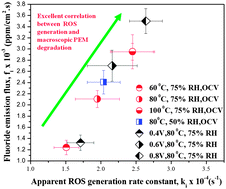In situ fluorescence spectroscopy correlates ionomer degradation to reactive oxygen species generation in an operating fuel cell†
Abstract
The rate of generation of reactive oxygen species (ROS) within the polymer electrolyte membrane (PEM) of an operating proton exchange member fuel cell (PEMFC) was monitored using in situ fluorescence spectroscopy. A modified barrier layer was introduced between the PEM and the electrocatalyst layer to eliminate metal–dye interactions and fluorescence resonance energy transfer (FRET) effects during measurements. Standard fuel cell operating parameters (temperature, relative humidity, and electrode potential) were systematically varied to evaluate their influence on the rate of ROS generation during PEMFC operation. Independently, the macroscopic rate of PEM degradation was measured by monitoring the fluoride ion emission rate (FER) in the effluent stream at each operating condition. The ROS generation reaction rate constant (estimated from the in situ fluorescence experiments) correlated perfectly with the measured FER across all conditions, demonstrating unequivocally for the first time that a direct correlation exists between in situ ROS generation and PEM macroscopic degradation. The activation energy for ROS generation within the PEM was estimated to be 12.5 kJ mol−1.


 Please wait while we load your content...
Please wait while we load your content...